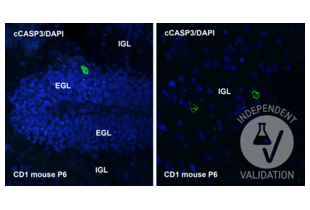Caspase 3 p17 (Cleaved-Asp175) Antikörper
Kurzübersicht für Caspase 3 p17 (Cleaved-Asp175) Antikörper (ABIN7251013)
Target
Reaktivität
Wirt
Klonalität
Konjugat
Applikation
-
-
Bindungsspezifität
- Cleaved-Asp175
-
Produktmerkmale
- Polyclonal Antibody
-
Aufreinigung
- Affinity purification
-
Immunogen
- Synthesized peptide derived from the Internal region of human Caspase-3 p17
-
Isotyp
- IgG
-
-
-
-
Applikationshinweise
- WB 1:500-2000, IHC 1:50-300, IF 1:50-300
-
Beschränkungen
- Nur für Forschungszwecke einsetzbar
-
-
- by
- Prof. Merighi, Laboratory of Neurobiology, Department of Veterinary Sciences, University of Turin
- No.
- #104629
- Datum
- 15.03.2025
- Antigen
- Caspase 3 p17
- Chargennummer
- DX03VBDV9989
- Validierte Anwendung
- Immunohistochemistry
- Positivkontrolle
The expression of caspase 3 at P5 was already attested in our laboratory (Lossi et al., 2004).
- Negativkontrolle
A control slice was processed for each experimental procedure, omitting the primary antibody.
- Bewertung
- Reference: Lossi L., Tamagno I. and Merighi A. (2004) “Molecular morphology of neuronal apoptosis: analysis of Caspase 3 activation during postnatal development of mouse cerebellar cortex.” J Mol Histol, 35(6):621-9.
- Primärantikörper
- ABIN7251013
- Sekundärantikörper
- anti-rabbit Alexa Fluor 488 (Invitrogen. Lot 2541675)
- Full Protocol
- Sample analyzed: mouse cerebellum at post-natal day (P) 5–6.
- Paraffin-embedded slices (7 µm thick) were deparaffinized and rehydrated through a graded series of alcohols and distilled water (dH2O).
- Sections were blocked in ovalbumin 1% 1 hour at room temperature.
- Antigen retrieval was performed in all the sections by microwave treatment (1 minute at 750 W + 1 minute at 250 W in citrate buffer pH 6).
- 3×5 minutes washing in 0.01 M PBS.
- Sections were incubated with the primary antibody at the following dilutions of 1:50/1:100/1:200, overnight at room temperature (primary antibody was diluted in PLL/BSA/PBS diluent).
- 3×5 minutes washing in 0.01 M PBS.
- Incubation with the anti-rabbit secondary antibody 1:400 in PLL/BSA/PBS diluent, 1 hour at room temperature.
- 3×5 minutes washing in 0.01 M PBS.
- Nuclear counterstaining was performed with DAPI 1 µg/mL, 2 minutes.
- 2×5 minutes washing in 0.01 M PBS.
- Specimens were then mounted in Fluoroshield mounting medium (Sigma).
- Anmerkungen
Passed. The antibody works in IHC-P at concentrations from 1:50-1:200
Validierung #104629 (Immunohistochemistry)![Erfolgreich validiert 'Independent Validation' Siegel]()
![Erfolgreich validiert 'Independent Validation' Siegel]() Validierungsbilder
Validierungsbilder![Expression of cleaved caspase 3 (cCASP3) in P6 mouse cerebellum. An immunoreactive Purkinje neuron (left) and two cCASP3-positive granule cells (right) after immunostaining with ABIN7251013 and nuclear counterstaining with 4′,6-Diamidine-2′-phenylindole dihydrochloride (DAPI). EGL = external granular layer of the cerebellar cortex; IGL = internal granular layer of the cerebellar cortex.]() Expression of cleaved caspase 3 (cCASP3) in P6 mouse cerebellum. An immunoreactive Purkinje neuron (left) and two cCASP3-positive granule cells (right) after immunostaining with ABIN7251013 and nuclear counterstaining with 4′,6-Diamidine-2′-phenylindole dihydrochloride (DAPI). EGL = external granular layer of the cerebellar cortex; IGL = internal granular layer of the cerebellar cortex.
Protokoll
Expression of cleaved caspase 3 (cCASP3) in P6 mouse cerebellum. An immunoreactive Purkinje neuron (left) and two cCASP3-positive granule cells (right) after immunostaining with ABIN7251013 and nuclear counterstaining with 4′,6-Diamidine-2′-phenylindole dihydrochloride (DAPI). EGL = external granular layer of the cerebellar cortex; IGL = internal granular layer of the cerebellar cortex.
Protokoll -
-
Format
- Liquid
-
Konzentration
- 1 mg/mL
-
Buffer
- PBS with 0.02 % sodium azide, 0.5 % BSA and 50 % glycerol, pH 7.4
-
Konservierungsmittel
- Sodium azide
-
Vorsichtsmaßnahmen
- This product contains Sodium azide: a POISONOUS AND HAZARDOUS SUBSTANCE which should be handled by trained staff only.
-
Lagerung
- -20 °C
-
Informationen zur Lagerung
- Store at -20°C. Avoid freeze / thaw cycles.
-
-
- Caspase 3 p17
-
Andere Bezeichnung
- CASP3 p17
-
Hintergrund
- Involved in the activation cascade of caspases responsible for apoptosis execution. At the onset of apoptosis it proteolytically cleaves poly(ADP-ribose) polymerase (PARP) at a '216-Asp-Gly-217' bond. Cleaves and activates sterol regulatory element binding proteins (SREBPs) between the basic helix-loop-helix leucine zipper domain and the membrane attachment domain. Cleaves and activates caspase-6, -7 and -9. Involved in the cleavage of huntingtin.
-
Molekulargewicht
-
Observed_MW: 20 kDa
Calculated_MW: 32 kDa
-
UniProt
- P42574
Target
-


 (1 Validierung)
(1 Validierung)



